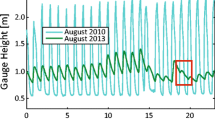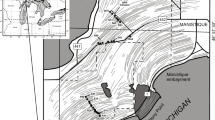Abstract
In the light of findings in recent years about the extent and nature of the hyporheal zone, the rate of uptake of organic matter by stream beds, and the fact that groundwater contains dissolved organic matter, it is suggested that stream ecologists should learn much more than they now know about groundwater. It seems probable that it is an important source of organic matter to the stream ecosystem which has escaped consideration to date.
Similar content being viewed by others
References
Bishop, J. E., 1973. Observations on the vertical distribution of the benthos in a Malaysian stream. Freshwat. Biol. 3: 147–156.
Bou, C. & Rouch, R., 1967. Un nouveau champ de recherches sur la faune aquatique souterraine. C. Acad. Sci. Paris D 265: 369–370.
Bretschko, G., 1980. Vertical distribution of zoobenthos in an alpine brook of the Ritrodat-Lunz study area. Verh. int. Ver. Limnol. 21: 873–876.
Coleman, M. J. & Hynes, H. B. N., 1970. The vertical distribution of the fauna in the bed of a stream. Limnol. Oceanogr. 15: 31–40.
Danielpol, D. L., 1976. The distribution of the fauna in the interstitial habitats of riverine sediments of the Danube and the Piesting (Austria). Int. J. Speleol. 8: 23–51.
Danielpol, D. L., 1980. The role of the limnologist in groundwater studies. Int. Revue ges. Hydrobiol. Hydrogr. 65: 777–791.
Ferrarese, U. & Samburgar, B., 1976. Ricerche sulla fauna interstitiale iporreica dell'Adige in relazione allo stato di inquinamente del fiume. Riv. Idrobiol. 15: 47–127.
Fisher, S. G. & Likens, G. E., 1973. Energy flow in Bear Brook, New Hampshire: An integrative approach to stream ecosystem metabolism. Ecol. Monogr. 43: 421–439.
Foster, S. S. D., Cripps, A. C. & Smith-Carington, A., 1982. Nitrate leaching to groundwater. Phil. Trans. Soc. Lond. 296: 477–489.
Frape, S. K. & Fritz, P., 1982. The chemistry and isotopic composition of saline groundwaters from the Sudbury basin, Ontario. Can. J. Earth Sci. 19: 645–661.
Frape, S. K. & Patterson, R. J., 1981. Chemistry of interstitial water and bottom sediments as indicators of patterns in Perch Lake, Chalk River, Ontario. Limnol. Oceanogr. 26: 500–517.
Freeze, R. A. & Cherry, J. A., 1979. Groundwater. Prentice-Hall, Englewood, Cliffs, New Jersey, 604 pp.
Godbout, L. & Hynes, H. B. N., 1982. The three dimensional distribution of the fauna in a single riffle in a stream in Ontario. Hydrobiologia 97: 87–96.
Gourbault, N. & Lescher-Moutoué, F., 1968. Sur la faune hypogée peuplant le sous-écoulement d'une rivière de moyenne altitude. C. Acad. Sci. Paris D 265: 1813–1816.
Hansen, E. A., 1975. Some effects of groundwater on brown trout redds. Trans. am. Fish. Soc. 104: 100–110.
Husmann, S., 1966. Versuch einer ökologischen Gleiderung des interstitiellen Grundwassers in Lebensbereiche eigener Prägung. Arch. Hydrobiol. 62: 231–268.
Husmann, S., 1971. Eine neue Methode zur Entnahme von Interstitialwasser aus subaquatischen Lockersteinen. Arch. Hydrobiol. 68: 519–527.
Husmann, S., 1978. Die Bedeutung der Grundwasserfauna für biologische Reinigungsvorgänge im Interstitial von Lockergesteinen. ‘G W F’ Wass. Abwass. 119: 293–302.
Hynes, H. B. N., 1970. The ecology of running waters. Liverpool University Press, Liverpool, 555 pp.
Hynes, H. B. N., 1974. Further studies on the distribution of stream animals within the substratum. Limnol. Oceanogr. 19: 92–99.
Hynes, H. B. N., 1975. The stream and its valley. Verb. int. Ver. Limnol. 19: 1–15.
Hynes, H. B. N., Williams, D. D. & Williams, N. E., 1976. Distribution of the benthos within the substratum of a Welsh mountain stream. Oikos 27: 307–310.
Johnson, R. A., 1980. Oxygen transport in salmon spawning gravels. Can. J. Fish. aquat. Sci. 37: 155–162.
Kaplan, L. A. & Bott, T. L., 1982. Diel fluctuations of DOC generated by algae in a piedmont stream. Limnol. Oceanogr. 27: 1091–1100.
Koboyashi, D., 1981. Separation of runoff components by stream temperature. Verh. Int. Verein. Limnol. 21: 150–154.
Lee, D. R. & Cherry, J. A., 1978. A field exercise on groundwater flow using seepage meters and mini-piezometers. J. Geol. Educ. 27: 6–10.
Lee, D. R. & Hynes, H. B. N., 1977/78. Identification of groundwater discharge zones in a reach of Hillman Creek in southern Ontario. Wat. Pollut. Res. Can. 13: 121–133.
Lock, M. A., 1981. River epilithon — a light and energy transducer. In: Lock, M. A. & Williams, D. D. (Eds.) Perspectives in running water ecology. Plenum Press, New York, 430 pp. 3–40.
Lock, M. A. & Hynes, H. B. N., 1975. The disappearance of four leaf leachates in a hard and soft water stream in South Western Ontario, Canada. Int. Revue ges. Hydrobiol. Hydrogr. 60: 847–855.
Lock, M. A. & Hynes, H. B. N., 1976. The fate of ‘dissolved’ organic carbon derived from autumn-shed maple leaves (Acer saccharum) in a temperate hardwater stream. Limnol. Oceanogr. 21: 436–443.
Lock, M. A., Wallace, R. R., Costerton, J. W., Ventullo, R. M. & Charlton, S. E., in press. River epilithon: toward a structural-functional model. Oikos.
Lush, D. L. & Hynes, H. B. N., 1978a. Particulate and dissolved organic matter in a small partly forested stream. Hydrobiologia 60: 177–185.
Lush, D. L. & Hynes, H. B. N., 1978b. The uptake of dissolved organic matter by a small spring stream. Hydrobiologia 60: 271–275.
Manny, B. A. & Wetzel, R. G., 1973. Diurnal changes in dissolved organic and inorganic carbon and nitrogen in a headwater stream. Freshwat. Biol. 3: 31–43.
McDowell, W. H. & Fisher, S. G., 1976. Autumnal processing of dissolved organic matter in a small woodland stream ecosystem. Ecology 57: 561–569.
Meŝtrov, M. & Lattinger-Penko, R., 1977/78. Ecological investigations of the influence of a polluted river on surrounding interstitial underground waters. Int. J. Speleol. 9: 331–355.
Meŝtrov, M. & Lattinger-Penko, R., 1981. Investigation of the mutual influence between a polluted river and its hyporheic. Int. J. Speleol. 11: 159–171.
Meŝtrov, M., Lattinger-Penko, R. & Tavcar, V., 1976. La dynamique de l'Isopode Proasellus slavus ssp. n. et les larves de Chironomides dans l'hyporhéique de la Drave du point de vue de la pollution. Int. J. Speleol. 8: 156–166.
Morris, D. L. & Brooker, M. P., 1979. The vertical distribution of macroinvertebrates in the upper reaches of the River Wye, Wales. Freshwat. Biol. 9: 573–584.
Naiman, R. G., 1982. Characteristics of sediment and organic carbon export from pristine boreal forest watersheds. Can. J. Fish. aquat. Sci. 39: 1699–1718.
Newbold, J. D., Mulholland, P. J., Elwood, J. W. & O'Neill, R. V., 1982. Organic carbon spiralling in stream ecosystems. Oikos 38: 266–272.
Ottaway, E. M., Carling, P. A., Clark, A. & Reader, N. A., 1981. Observations on the structure of brown trout, Salmo trutta Linnaeus, redds. J. Fish Biol. 19: 593–607.
Poole, W. C. & Stewart, K. W., 1976. The vertical distribution of macrobenthos within the substratum of the Brazos River, Texas. Hydrobiologia 50: 151–160.
Pugsley, C. W. & Hynes, H. B. N., in press. A modified freezecore technique to quantify the depth distribution of fauna in stony streambeds. Can. J. Fish. aquat. Sci. 40:
Radford, D. S. & Hartland-Rowe, R., 1971. Subsurface and surface sampling of benthic invertebrates in two streams. Limnol. Oceanogr. 16: 114–120.
Rounick, J. S., Winterbourn, M. J. & Lyon, G. L., 1982. Differential utilization of allochthonous and autochthonous inputs by aquatic invertebrates in some New Zealand streams: a stable carbon isotope study. Oikos 39: 191–198.
Schwoerbel, J., 1961. Über die Lebensbedingungen und die Besiedlung des hyporheischen Lebensraumes. Arch. Hydrobiol. Suppl. 25: 181–214.
Schwoerbel, J., 1967. Das hyporheische Interstitial als Grenzbiotop zwischen oberirdischem und subteränem Ökosystem und seine Bedeutung für die Primär-Evolution von Kleinsthöhlenbewohnern. Arch. Hydrobiol. Suppl. 33: 1–62.
Sherr, E. B., 1982. Carbon isotope composition of organic seston and sediments in a Georgia salt marsh estuary. Geochim. cosmochim. Acta 46: 1227–1232.
Sklash, M. G., Farvolden, R. N. & Fritz, P., 1976. A conceptual model of watershed response to rainfall, developed through the use of oxygen-18 as a natural tracer. Can. J. Earth Sci. 13: 271–283.
Stanford, J. A. & Gaufin, A. R., 1974. Hyporheic communities of two Montana rivers. Science 185: 700–702.
Štěrba, O., 1978. Stratifikation der Organismen in der Oberschicht der Sand kiessedimente unter der aktiven Strömung der Flüsse. Vešt. čsk. Spol. zool. 42: 60–68.
Štěrba, O. & Holzer, M., 1977. Fauna de interstitiellen Gewässer der Sandkiessedimente unter der aktiven Strömung. Vešt. čsk. Spol. zool. 41: 144–159.
Telang, S. A., Baker, B. L., Costerton, J. W., Ladd, T., Mutch, R., Wallis, P. M. & Hodgson, G. W., 1982. Biogeochemistry of mountain stream waters: the Marmot system. Scient. Ser. 101. Inland Waters Directorate, Ottawa, 101 pp.
Vaux, W. G., 1962. Interchange of stream and intergravel water in a salmon spawning riffle. Spec. Sci. Publ., U.S. Fish Wildl. Serv., Fish. 405, 11 pp.
Wallis, P. M., Hynes, H. B. N. & Telang, S. A., 1981. The importance of groundwater in the transportation of allochthonous dissolved organic matter to the streams draining a small mountain basin. Hydrobiologia 79: 77–90.
Webster, D. A. & Eriksdotter, G., 1976. Upwelling water as a factor influencing choice of spawning sties by brook trout (Salvelinus fontinalis). Trans. am. Fish. Soc. 105: 416–421.
Welton, J. A., Ladle, M., Bass, J. A. B. & Chapman, K., 1981. Invertebrate sampling in the substratum of an experimental recirculating stream. Int. Revue ges. Hydrobiol. Hydrogr. 66: 407–414.
Whitman, R. L. & Clark, W. J., 1982. Availability of dissolved oxygen in interstitial waters of a sandy creek. Hydrobiologia 92: 651–658.
Williams, D. D., 1976. Aquatic invertebrates inhabiting agricultural drainage tile systems in Ontario. Can. Fd. Nat. 90: 193–195.
Williams, D. D. & Hynes, H. B. N., 1974. The occurrence of benthos deep in the substratum of a stream. Freshwat. Biol. 4: 233–256.
Winograd, I. J. & Robertson, F. N., 1982. Deep oxygenated ground water: anomaly or common occurrence? Science 216: 1227–1230.
Author information
Authors and Affiliations
Rights and permissions
About this article
Cite this article
Hynes, H.B.N. Groundwater and stream ecology. Hydrobiologia 100, 93–99 (1983). https://doi.org/10.1007/BF00027424
Issue Date:
DOI: https://doi.org/10.1007/BF00027424




